The global freeze-dried food market is valued at USD 32.3 billion in 2025 and is expected to reach USD 59.7 billion by 2035, registering a CAGR of 6.3%. The rising consumer demand for ready-to-eat and nutrient-dense food products with long shelf lives is driving the adoption of freeze-dried food globally.
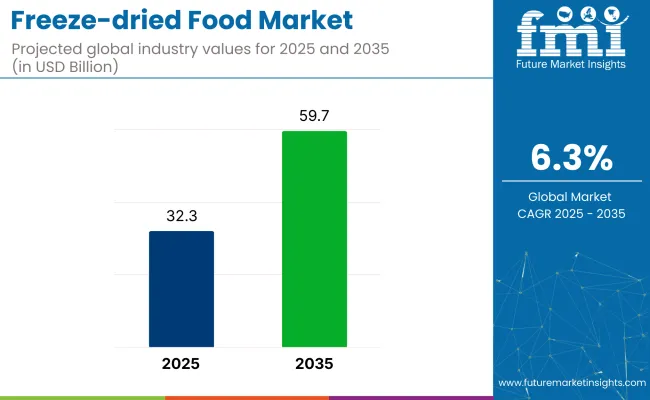
| Metric | Value |
|---|---|
| Estimated Size (2025) | USD 32.3 billion |
| Projected Value (2035) | USD 59.7 billion |
| CAGR (2025 to 2035) | 6.3% |
Key factors supporting this growth include busy lifestyles, increasing reliance on emergency food supplies, and strong demand from sectors such as bakeries, beverages, and snacks. In particular, freeze-dried fruits and vegetables are gaining prominence due to their ability to retain most nutrients and flavor without refrigeration.
In 2025, the United States is projected to remain the largest market for freeze-dried food, contributing to North American sales. The market in the USA is expected to grow at a CAGR of 5.3%. Meanwhile, the UK and Japan closely follow this growth with CAGRs of 4.8% and 4.5% respectively. Powdered freeze-dried fruits are anticipated to maintain dominance in formtypewith 48% of the market share, while,by nature, conventional products hold a prominent share of 85% in 2025.
The market holds a notable share across several parent markets due to its unique advantages, like extended shelf life and nutrient retention. It accounts for approximately 6-8% of the global processed food market and nearly 10% of the convenience food segment, driven by rising demand for ready-to-eat options.
Within the functional food market, it represents around 4-5%, primarily through fortified freeze-dried fruits and vegetables. In the emergency and survival food market, freeze-dried products dominate with over 35% share, owing to their longevity and portability. Its share in the snack food category stands at an estimated 3-4%.
Per capita spending on freeze-dried food is increasing globally, driven by rising demand for convenient, shelf-stable, and nutrient-retaining food options. This category includes snacks, fruits, meals, and emergency preparedness products that appeal to health-conscious consumers, outdoor enthusiasts, and busy households.
The global trade of freeze-dried food is expanding as demand for lightweight, long-shelf-life, and nutrient-rich food products grows across both developed and emerging markets. Freeze-dried items such as fruits, vegetables, meats, dairy, and ready meals are in high demand for applications in outdoor recreation, emergency preparedness, and health-focused snacking.
The global market is segmented into product type, nature, form, and region. Under product type, it includes fruits (strawberry, raspberry, pineapple, apple, mango, and other fruits), vegetables (carrot, potato, corn, pea, mushroom, and other vegetables), freeze-dried dairy products, freeze-dried meat & seafood, freeze-dried pet food, and prepared meals.
The nature segment comprises organic and conventional. The form segment includes powdered, granules, and diced. The regional analysis spans North America, Latin America, Europe, East Asia, South Asia, Oceania, the Middle East and Africa.
Fruits are expected to remain the most lucrative product type, accounting for over 40% of market share in 2025. Their widespread use in snacks, cereals, bakery, and dietary products is driving adoption. Among fruits, strawberries and apples are preferred due to their versatility, natural sweetness, and long shelf life. These fruits retain flavor and nutritional value after freeze-drying, making them highly suitable for health-conscious consumers and foodservice applications.
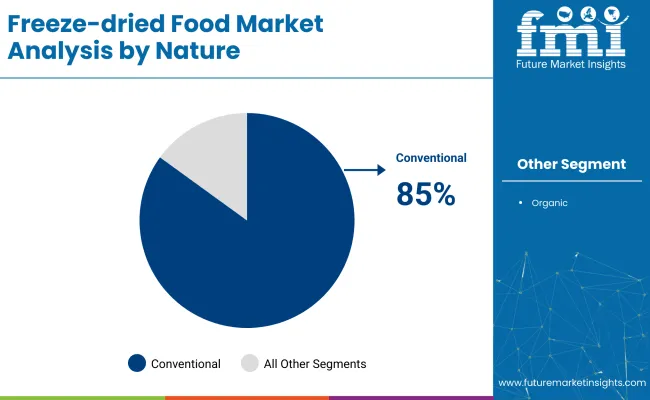
The conventional segment is projected to retain dominance with a share of around 85% in 2025. Cost-effectiveness and wide availability make conventional freeze-dried food more accessible to large-scale manufacturers and foodservice providers. While organic products are gaining traction, their higher price point and limited sourcing still restrict widespread adoption across middle-income economies.
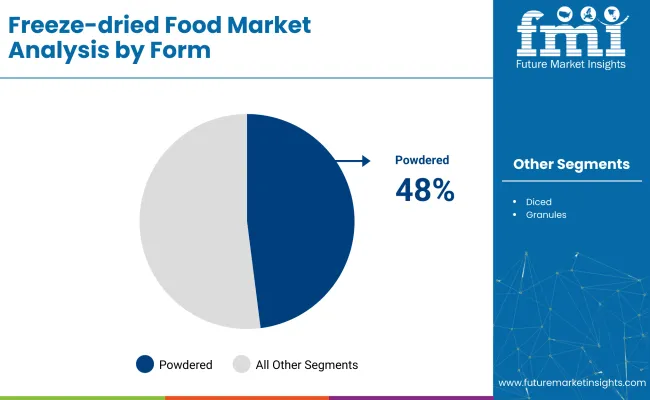
Powdered freeze-dried food is set to lead the form segment with nearly 48% share in 2025, owing to its application in beverages, infant nutrition, and functional foods. Powders offer excellent solubility and shelf stability, making them a preferred format for both B2B and retail users. They are also easy to transport and mix with liquids or recipes, enhancing convenience.
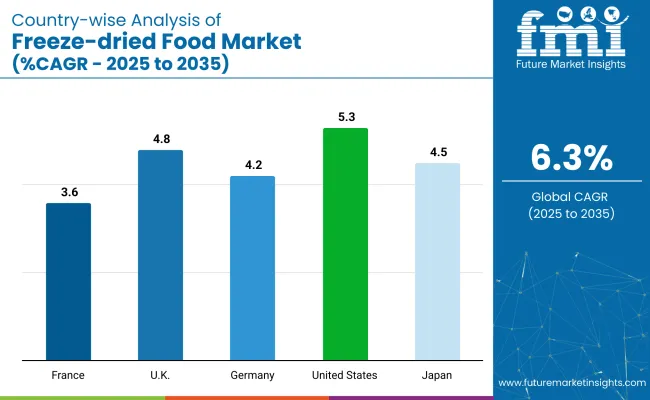
Among the top five countries, the USA leads the freeze-dried food market with a CAGR of 5.3% from 2025 to 2035, supported by a robust food processing industry and demand for emergency and clean-label products. Japan follows with a 4.5% CAGR, driven by innovation and demand for convenience foods.
The UK posts steady growth at 4.8%, fueled by plant-based and minimally processed food trends. Germany shows a 4.2% CAGR, backed by advanced manufacturing capabilities, while France exhibits the slowest growth at 3.6%, due to a national preference for fresh and refrigerated food options.
The report covers an in-depth analysis of 40+ countries; five top-performing OECD countries are highlighted below.
The freeze-dried food revenue in the USA is projected to grow at a CAGR of 5.3% from 2025 to 2035. The USA continues to lead the global market owing to a mature food processing industry, high demand for emergency and long-shelf-life foods, and increasing consumer preference for clean-label, preservative-free ingredients.
Widespread adoption of freeze-dried products in meal kits, snacks, and beverages is fueling market expansion. Additionally, strong B2B demand from bakeries and health food manufacturers is contributing to steady growth.
The UK freeze-dried food market is anticipated to expand at a CAGR of 4.8% between 2025 and 2035. Growth is being driven by increasing consumption of ready-to-eat and shelf-stable foods, particularly in urban areas. The UK’s growing vegan and health-conscious population prefers freeze-dried fruit and vegetable ingredients in cereals, smoothies, and snacks. Regulatory emphasis on sustainable packaging and reduced food waste is pushing innovation.
The revenue from freeze-dried food in Germany is forecasted to register a CAGR of 4.2% during the 2025 to 2035 period. A well-established processed food industry, combined with growing demand for nutrient-rich snack alternatives, is supporting market growth. Freeze-dried fruits and vegetables are being widely adopted in dairy products, breakfast cereals, and sports nutrition. Germany’s technological edge in food manufacturing supports high-quality output.
The sales of freeze-dried food in France are expected to grow at a CAGR of 3.6% from 2025 to 2035. France’s market remains moderate due to a strong preference for fresh and refrigerated foods. Nonetheless, rising interest in organic and functional food options is gradually increasing the demand for freeze-dried fruits and vegetables. Growth is also supported by innovation in gourmet freeze-dried products and France’s participation in international food aid and emergency supply programs.
The freeze-dried food market in Japan is projected to flourish at a CAGR of 4.5% between 2025 and 2035. The country’s strong emphasis on technology, quality, and convenience has driven widespread adoption of freeze-dried foods in soups, instant meals, and health snacks.
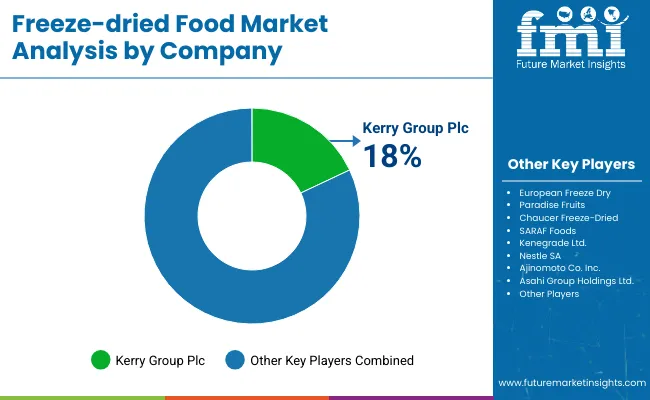
The market is highly fragmented, with a mix of multinational corporations, mid-sized regional players, and niche-focused startups competing for share. Top-tier companies like Nestlé SA, Kerry Group Plc, Mondelez International, and Unilever Group hold a significant portion of the market by leveraging extensive distribution networks, product diversification, and global manufacturing capabilities. Mid-level firms such as European Freeze Dry and Mercer Foods are building regional dominance by focusing on specific consumer segments and contract manufacturing services.
Competitive strategies in this space revolve around product innovation, clean-label offerings, pricing efficiency, and sustainability initiatives. Leading brands are enhancing their freeze-drying capabilities to improve flavor retention, nutrient preservation, and shelf stability.
Firms are also investing in eco-friendly packaging and organic sourcing to meet growing consumer demand for sustainable, health-conscious options. Partnerships, new product launches for dietary and emergency-preparedness markets, and geographical expansion into emerging economies are driving competitive advantage among the top players.
In December 2024, Unilever unveiled an agreement to acquire Unox and Zwan brands. It secured a binding offer from Zwanenberg Food Group.
| Report Attributes | Details |
|---|---|
| Current Total Market Size (2025) | USD 32.3 billion |
| Projected Market Size (2035) | USD 59.7 billion |
| CAGR (2025 to 2035) | 6.3% |
| Base Year for Estimation | 2024 |
| Historical Period | 2020 to 2024 |
| Projections Period | 2025 to 2035 |
| Market Analysis Parameters | Revenue in USD billions/Volume in kilotons |
| By Product Type | Fruits (Strawberry, Raspberry, Pineapple, Apple, Mango, Others), Vegetables (Carrot, Potato, Corn, Pea, Mushroom, Others), Freeze-Dried Dairy Products, Freeze-Dried Meat & Seafood, Freeze-Dried Pet Food, Prepared Meals |
| By Nature | Organic, Conventional |
| By Form | Powdered, Granules, Diced |
| Regions Covered | North America, Latin America, Europe, East Asia, South Asia, Oceania, the Middle East and Africa |
| Countries Covered | United States, Canada, United Kingdom, Germany, France, China, Japan, South Korea, Brazil, Australia |
| Key Players | Kerry Group Plc, European Freeze Dry, Paradise Fruits, Chaucer Freeze-Dried, SARAF Foods, Kenegrade Ltd., Nestle SA, Ajinomoto Co. Inc., Asahi Group Holdings Ltd., Harmony House Foods Inc., Lyofood Sp. zo.o ., Mercer Foods LLC, Nuts.com, The Kraft Heinz Co., Freeze Dry Foods LLC, Mondelez International Inc., SouthAm Freeze Dry, The Hain Celestial Group Inc., Molda AG, Unilever Group |
| Additional Attributes | Dollar sales by value, market share analysis by region, and country-wise analysis |
Global freeze-dried food category is segmented as Fruits (Strawberry, Raspberry, Pineapple, Apple, Mango, Other Fruits), Vegetables (Carrot, Potato, Corn, Pea, Mushroom, Other Vegetables), Freeze-Dried Dairy Product, Freeze-Dried Meat and Seafood, Freeze-Dried Pet Food, Prepared Meal
The industry is further segmented as Organic and Conventional
The segment further includes as Powdered, Granules and Diced
This segment further includes Food & Beverages Products (Breakfast Cereals, Dairy Products, Bakery & Confectionery, Nutritional Bars & Supplements, Powdered Beverages, and Snacks) and Retail (household)
By distribution channel it is further segmented as B2B and B2C (Hypermarkets/Supermarkets, Convenience Store, Specialty Store, Food & Drinks Specialty Store, Independent Small Grocery Store, Online Retail)
Industry analysis has been carried out in key countries of North America, Latin America, Europe, East Asia, South Asia, Oceania and Middle East & Africa
The market is valued at USD 32.3 billion in 2025.
The market is forecasted to reach USD 59.7 billion by 2035, reflecting a CAGR of 6.3%.
The fruits are expected to lead the market with a 40% share in 2025.
The conventional products are expected to hold an 85% market share in 2025.
The USA is anticipated to be the fastest-growing market with a CAGR of 5.3% from 2025 to 2035.






Our Research Products

The "Full Research Suite" delivers actionable market intel, deep dives on markets or technologies, so clients act faster, cut risk, and unlock growth.

The Leaderboard benchmarks and ranks top vendors, classifying them as Established Leaders, Leading Challengers, or Disruptors & Challengers.

Locates where complements amplify value and substitutes erode it, forecasting net impact by horizon

We deliver granular, decision-grade intel: market sizing, 5-year forecasts, pricing, adoption, usage, revenue, and operational KPIs—plus competitor tracking, regulation, and value chains—across 60 countries broadly.

Spot the shifts before they hit your P&L. We track inflection points, adoption curves, pricing moves, and ecosystem plays to show where demand is heading, why it is changing, and what to do next across high-growth markets and disruptive tech

Real-time reads of user behavior. We track shifting priorities, perceptions of today’s and next-gen services, and provider experience, then pace how fast tech moves from trial to adoption, blending buyer, consumer, and channel inputs with social signals (#WhySwitch, #UX).

Partner with our analyst team to build a custom report designed around your business priorities. From analysing market trends to assessing competitors or crafting bespoke datasets, we tailor insights to your needs.
Supplier Intelligence
Discovery & Profiling
Capacity & Footprint
Performance & Risk
Compliance & Governance
Commercial Readiness
Who Supplies Whom
Scorecards & Shortlists
Playbooks & Docs
Category Intelligence
Definition & Scope
Demand & Use Cases
Cost Drivers
Market Structure
Supply Chain Map
Trade & Policy
Operating Norms
Deliverables
Buyer Intelligence
Account Basics
Spend & Scope
Procurement Model
Vendor Requirements
Terms & Policies
Entry Strategy
Pain Points & Triggers
Outputs
Pricing Analysis
Benchmarks
Trends
Should-Cost
Indexation
Landed Cost
Commercial Terms
Deliverables
Brand Analysis
Positioning & Value Prop
Share & Presence
Customer Evidence
Go-to-Market
Digital & Reputation
Compliance & Trust
KPIs & Gaps
Outputs
Full Research Suite comprises of:
Market outlook & trends analysis
Interviews & case studies
Strategic recommendations
Vendor profiles & capabilities analysis
5-year forecasts
8 regions and 60+ country-level data splits
Market segment data splits
12 months of continuous data updates
DELIVERED AS:
PDF EXCEL ONLINE
Freeze-Dried Pet Food Market Anlysis by Pet Type, Nature, Source, Process Type, and Sales Channel Through 2035
USA Freeze-Dried Food Market Growth – Demand, Trends & Forecast 2025-2035
Food & Beverage OEE Software Market Size and Share Forecast Outlook 2025 to 2035
Food Grade Crosslinked Polyvinylpolypyrrolidone (PVPP) Market Size and Share Forecast Outlook 2025 to 2035
Food Grade Cassia Gum Powder Market Size and Share Forecast Outlook 2025 to 2035
Food Grade Dry Film Lubricant Market Size and Share Forecast Outlook 2025 to 2035
Foodservice Equipment Market Analysis - Size, Share, and Forecast Outlook 2025 to 2035
Food Basket Market Forecast and Outlook 2025 to 2035
Food Grade Tremella Polysaccharide Market Size and Share Forecast Outlook 2025 to 2035
Food Sorting Machine Market Size and Share Forecast Outlook 2025 to 2035
Foodservice Paper Bag Market Size and Share Forecast Outlook 2025 to 2035
Food Stabilizers Market Size and Share Forecast Outlook 2025 to 2035
Food Packaging Film Market Size and Share Forecast Outlook 2025 to 2035
Food Certification Market Size and Share Forecast Outlook 2025 to 2035
Food Tray Market Size and Share Forecast Outlook 2025 to 2035
Food & Beverage Industrial Disinfection and Cleaning Market Size and Share Forecast Outlook 2025 to 2035
Food Technology Market Size and Share Forecast Outlook 2025 to 2035
Food Tourism Sector Market Size and Share Forecast Outlook 2025 to 2035
Food Processing Boiler Market Size and Share Forecast Outlook 2025 to 2035
Food Packaging Machines Market Size and Share Forecast Outlook 2025 to 2035

Thank you!
You will receive an email from our Business Development Manager. Please be sure to check your SPAM/JUNK folder too.
Chat With
MaRIA